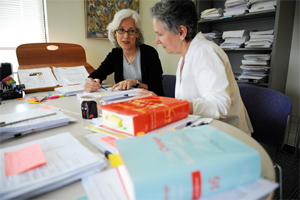Manual 16.0
The new edition of Chicago’s style bible is a testament to the online-publishing explosion.
By Asher Klein ‘11
Photography by Dan Dry

Editors Carol Fisher Saller, left, and Anita Samen weave a web of new guidelines.
There are longstanding debates in publishing about the best ways to write about the Internet and the best ways to use it. The 16th edition of the Chicago Manual of Style (CMOS), published in August by the University of Chicago Press, offers new interpretations of both issues.
The new edition dropped the more formal spelling of “Web site” in favor of “website,” following the Associated Press’s similar move in April—one of many web-related style changes in the new Manual. But it’s the CMOS website itself that reflects substantive changes in how the Internet influences publishing.
The online complement to the new CMOS went live in conjunction with the 104-year-old style guide arriving in bookstores. The simultaneous publication was a big step for the Press’s “jewel in the crown,” as Managing Editor Anita Samen calls the Manual, and one that intimates a new level of interaction between the editors who wrote it and the ones who use it. “Every thought we had about the [16th] edition, we thought about the online and the print together,” says Lindsay Dawson, the Press’s promotions manager.
The online version, up since 2006, four years after the Manual’s 15th edition came out, has been available for a $35 annual subscription. Now that the print and online editions are competing, Dawson says, Press staffers anticipate fewer print sales, but they could be wrong: “It’s a total learning experience for us.”
One thing is clear: the Press has embraced the web to get people talking about the style guide; this year saw CMOS’s first foray into social networking, including a forum to foster community among publishing professionals, to which all 6,000 individual online subscribers have access.
The editors created the forum, Samen says, to “establish a real online community, especially if you’re an editor or a writer and you’re working alone, or if you’re a small publisher and you want to be able to benefit from the expertise of some big publishers who’ve dealt with situations that you may not have dealt with.” Editors also set up Twitter and Facebook accounts, which have more than 2,700 followers and almost 11,000 fans, respectively.
Inside the pastel blue cover of the CMOS, the lion’s share of new content is devoted to digital work. The editors updated citation rules for electronic sources such as blogs and podcasts, gave more coverage to web-related copyright law, and referred to other organizations “when we’ve found that there’s a free online source that covers an issue bigger and better than we can,” editor Carol Fisher Saller says.
They rewrote headers, packaging likely search terms into each rule (e.g. “Swedish special characters,” rather than “Special characters,” in the section on Swedish type). “It helps amazingly when you’re searching for stuff,” Saller says. “No one is going to notice that, really, as a change, but it was a major change.”
One of the most forward-thinking additions—an appendix on the computer formatting code Extensible Markup Language (XML)—recalls the CMOS’s origins. The first edition, published in 1906, included pages of typefaces for typesetters outside the University Press to consult, as well as formatting rules. These days word processors use XML to lay words out on the page. Manipulating the code can make the text more interactive or aesthetically pleasing, but few publishers know how to do it properly, if at all.
It’s not the Press’s first time leading the electronic-publishing pack. In 1987 it was one of the first presses to produce an electronic-publishing guidebook, and it became one of the first to post its style guide online in 2006. As quickly as things change in the digital age, the editors are already considering the 17th edition, keeping a file of revisions to consider, many user-generated.
“We have all this technology now,” Samen says, “so we get a lot of input from our users, and bless them for that. They let us know what they like, they let us know what maybe they don’t like so much, and they let us know how things work for them as they’re writing and editing.”Return to top
